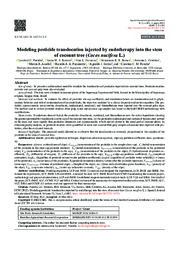Modeling pesticide translocation injected by endotherapy into the stem of coconut tree (Cocos nucifera L.).
Modeling pesticide translocation injected by endotherapy into the stem of coconut tree (Cocos nucifera L.).
Author(s): PARAIBA, L. C.; FERREIRA, J. M. S.; FERRACINI, V. L.; RAMOS, S. R. R.; CERDEIRA, A. L.; ASSALIN, M. R.; PAZIANOTTO, R. A. A.; SANTOS, A. J. dos; PARAÍBA, C. C. M.
Summary: Abstract: Aim of study: To present a mathematical model to simulate the translocation of pesticides injected into coconut trees. Pesticide residues in water and coconut pulp were also evaluated.Area of study: The data were obtained in coconut plants of the Itaporanga Experimental Field, located in the Municipality of Itaporanga d'Ajuda, Sergipe State, Brazil.Material and methods: To estimate the effect of pesticide site-sap coefficients and retardation factors on translocation and its phytosanitary behavior and risk of contamination of coconut fruits, the stipe was modeled by a classic dispersion-advection equation. The pesticides cyproconazole, azoxystrobin, dimethoate, imidacloprid, metalaxyl, and thiamethoxam were injected into the coconut palm stipe. The method used to extract pesticide residues from pulp, water and coconut sap samples was based on the QuEChERS methodology with modifications.Main results: Simulations showed that (i) the pesticides dimethoate, metalaxyl, and thiamethoxan were the active ingredients showing the greatest potential for translocation in the sap of the coconut tree stem; (ii) the pesticides imidacloprid and metalaxyl translocated upward in the stipe, and more rapidly than pesticides abamectin and cyproconazole, which moved slower to the aerial part of coconut plants. In chromatography analysis, no pesticide residues were quantified in water and coconut fruit pulp samples of coconut trees injected with pesticides, after the evaluated intervals.Research highlights: The proposed model allowed us to observe that the translocation is inversely proportional to the sorption of the pesticide in the stem of coconut trees.
Publication year: 2022
Types of publication: Journal article
Unit: Embrapa Environment
Observation
Some of Embrapa's publications are published as ePub files. To read them, use or download one of the following free software options to your computer or mobile device. Android: Google Play Books; IOS: iBooks; Windows and Linux: Calibre.
Access other publications
Access the Agricultural Research Database (BDPA) to consult Embrapa's full library collection and records.
Visit Embrapa Bookstore to purchase books and other publications sold by Embrapa.

